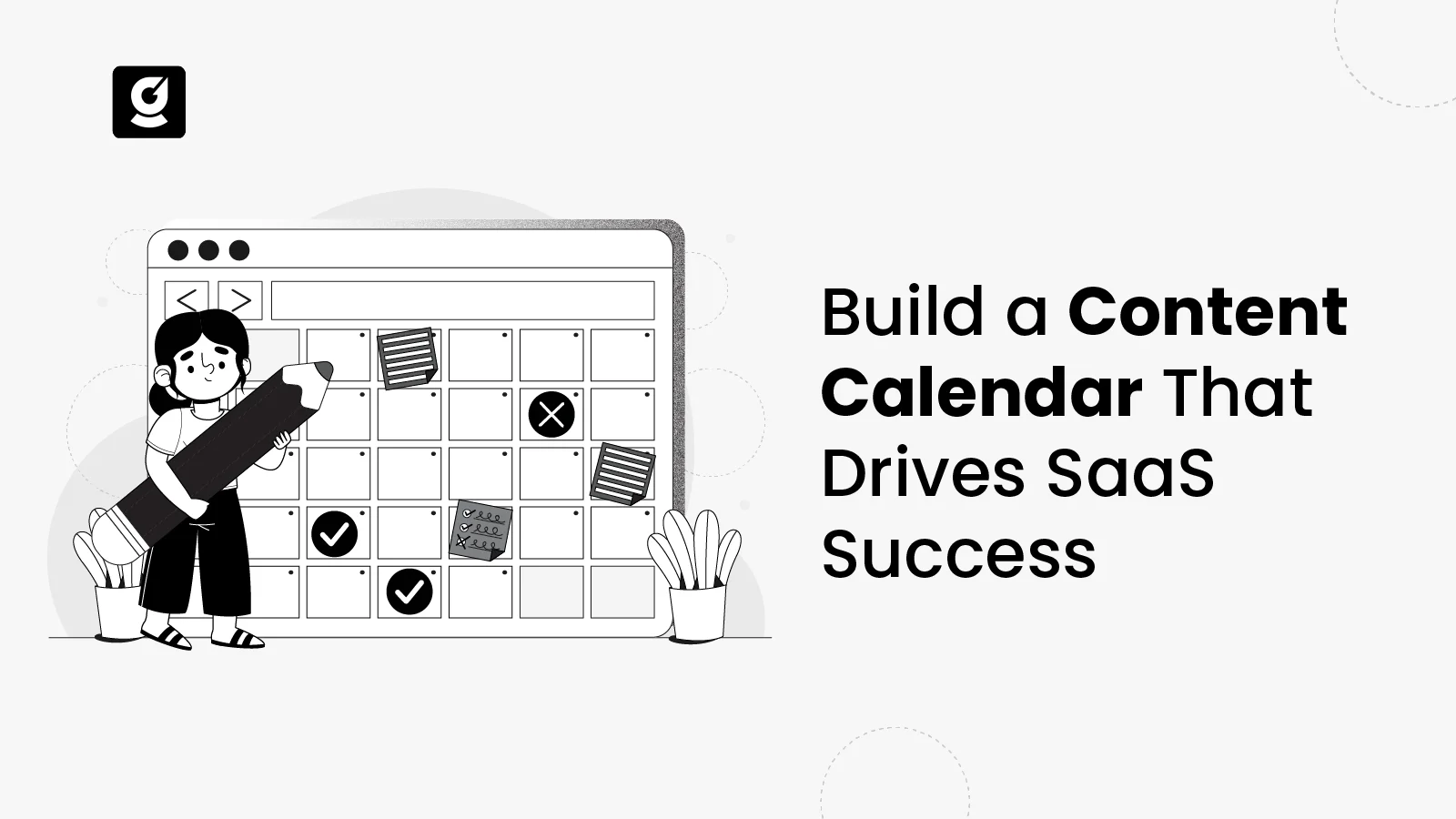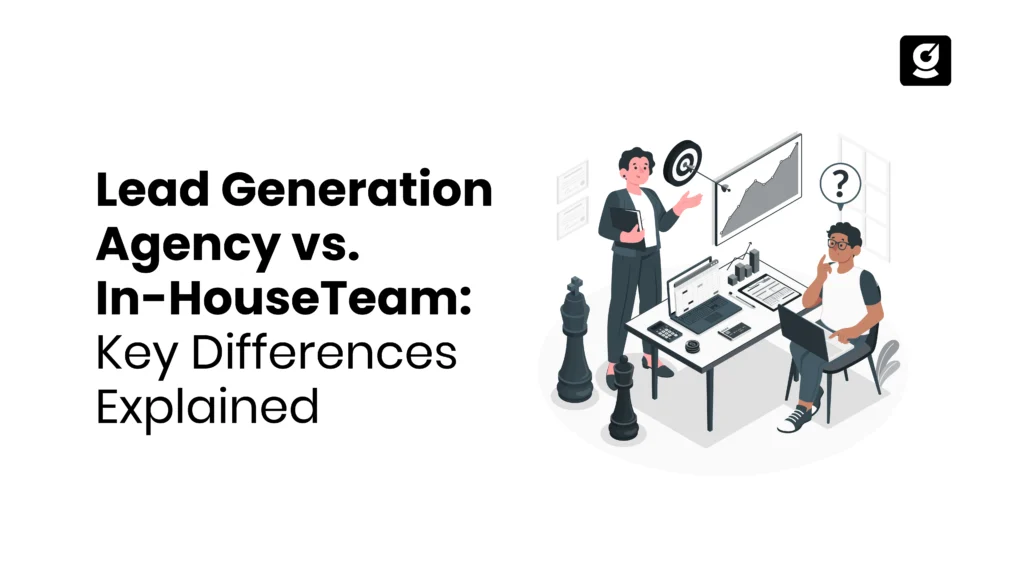Are you struggling to keep your SaaS content marketing on track? Without a well-organized approach, it is easy to lose sight of your goals and miss valuable opportunities to connect with your audience. This is where a content calendar becomes necessary.
Get a clear, strategic plan that’s not only aligned with your marketing goals, but also resonates with niche audiences. This tool’s more than just a content scheduling tool; it’s a roadmap for consistently delivering high-quality, targeted content.
In this blog, we’ll talk about how to make a result-driven content calendar for your SaaS business.
How To Create A Content Calendar For Your SaaS Business?
Creating a content calendar for your SaaS business will streamline your strategy and ensure that your marketing is both effective and organized. Follow these steps to make a great content calendar.
1. Understand Your Target Audience.
Knowing who’s on the other side of the screen, reading your content, is important in content strategy. It’s all about creating content that resonates with your target audience. Whether you’re creating blog posts, webinars, or social media content, understanding your audience ensures that your content sticks with their needs.
You can set this up by using these tips,
You can make a survey: Taking a survey is straightforward and super effective. You can pop a quick survey on your website or send it out as part of the newsletter. You can ask questions like,
- What topics are they interested in?
- What formats do they prefer?
This type of feedback can guide your content creation directly based on user preferences.
Remember, the goal is to craft content that feels like it’s made just for them. When you pay attention to your audience’s needs and preferences, you can fill up your content calendar in a way that creates a community that anticipates your posts, videos, and tweets.
2. Setting Clear Objectives
Setting up clear objectives will guide your content strategy and help you measure its success. Here are some common goals that SaaS companies might aim for:
- Awareness: You have to aim your content to increase brand awareness. This involves creating educational content that highlights the relevance and benefits of your product/service.
- Lead Generation: write content that aims at lead generation, and it needs to capture the contact details of potential customers. You can include downloadable resources, webinars, or free tool trials. All of these require users to provide their email addresses so that you can take this as for getting new leads for your brand.
- Conversion: If you need proper conversion, all your content needs to do is convince targeted customers of your product’s value. So write proper case studies, detailed product details, and customer testimonials that show them the success of your clients with your software.
- Customer Retention: Keep your customers engaged through properly engaging content to focus on providing content through valuable tips, updates, and uses of your product/service.
Specifying these objectives helps create targeted content and sets the metrics for measuring content effectiveness. These practices will help you increase engagement rates and conversion rates for your saas product.
3. Research and Content Mapping
You have to do proper audience research for setting up your content calendar. You have to include proper insights about your potential customers’ demographics, pain points, and content formats.
- Customers’ personalities: Create detailed personas for your typical customers. You can include roles, industries, challenges they face, and goals they aim to achieve with your software.
- Customer Feedback: Use surveys, customer support interactions, and social media engagement to collect feedback and understand what your audience truly cares about.
- Competitor Analysis: Competitor analysis also benefits you from observing the types of content your competitors are creating. What works for them can provide insights into what might work for you.
After you understand your audience, map out content topics that align with their interests and your business objectives. This content mapping ensures that each piece of content serves a specific purpose and reaches a particular segment of your audience effectively.
4. Choose A Content Calendar Generator
There are two ways that you can create a content calendar for your saas business. You can create one for yourself with the help of a content calendar generator.
Suppose you don’t have any time to spend creating a content calendar for your business. You can go and get help from a reputed content calendar generator tool. There are so many content calendar tools that help you create one, like Google Sheets, Microsoft Excel, SuiteJar, and more.
SuiteJar is an SEO and content marketing tool that provides an AI-driven content calendar generator that helps you create a complete calendar within seconds. You only have to add some key points of your SaaS business in the tool that will give you all the topics easily.
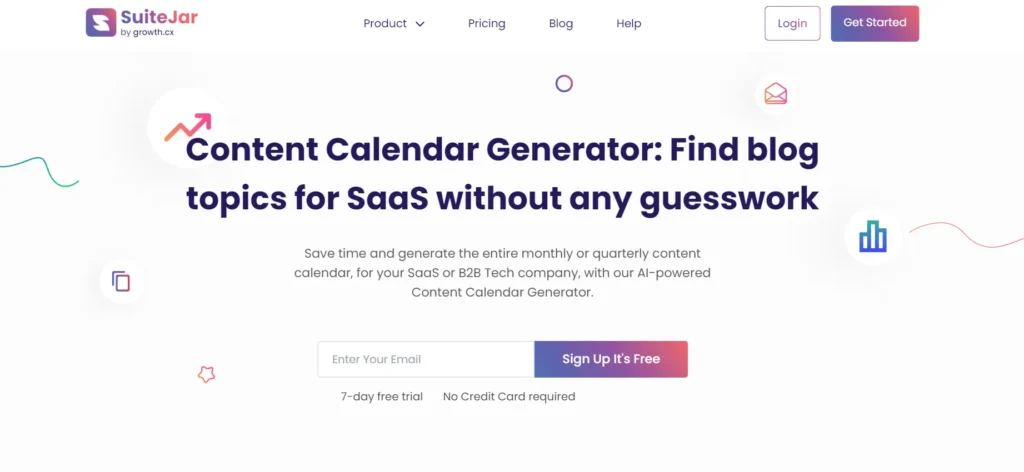
The feature starts by giving you space to insert all the points about your SaaS business. You only need to add points as per your website needs,
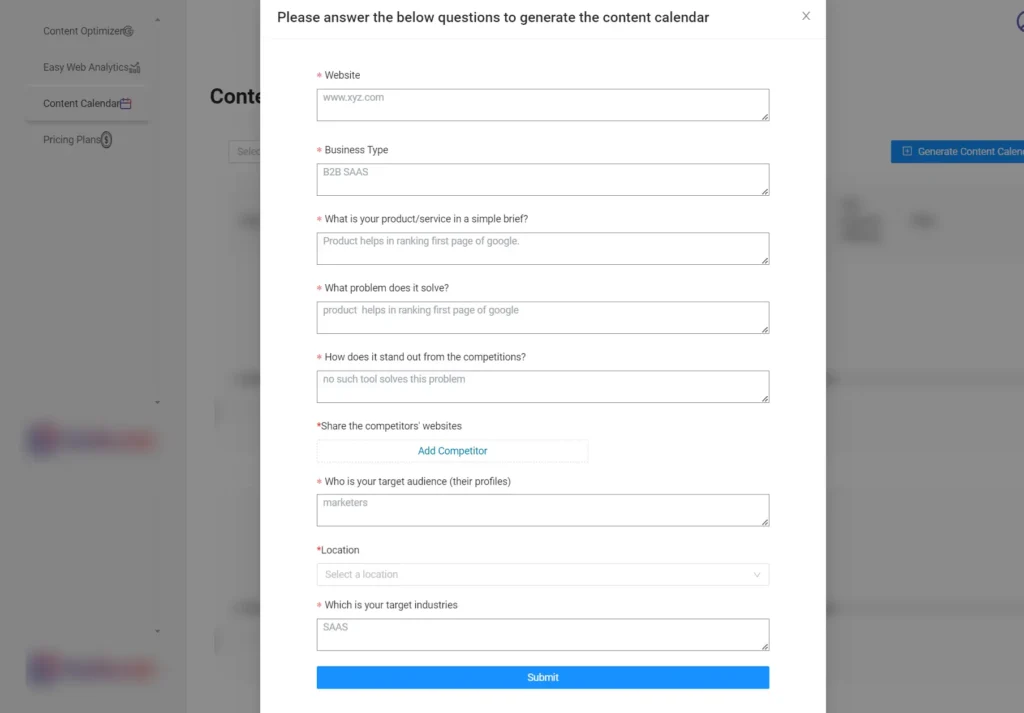
- Website URL
- Business type
- What is your product/service? Can you explain it in a simple brief?
- What problem does it solve?
- How does it stand out from the competition?
- Share the competitors’ websites.
- Who is your target audience (their profiles)?
- Location
- Which are your target industries?
Next, you can just enter it using the ‘submit’ button. There comes a section where you can add keywords that are apt for your niche.
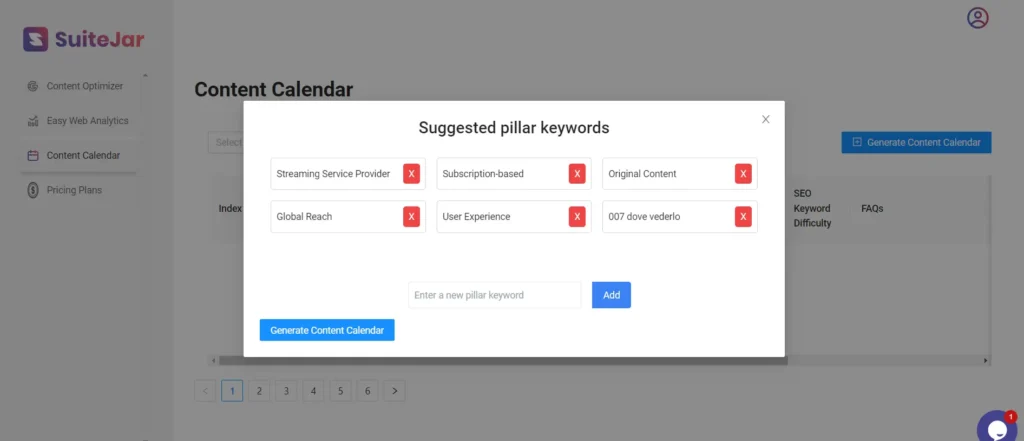
Also, the suitejar feature itself gives some keyword suggestions so that you will get a proper understanding of keywords of your industry and competitors. This helps you get keywords that you missed when researching your industry.
Click on ‘Submit‘ so that you will get complete calendar details with the proper sections. You will get details within the sections like,
- Pillar keyword
- Cluster keyword
- Topic
- Type of page
- Funnel
- Search volume and search difficulty
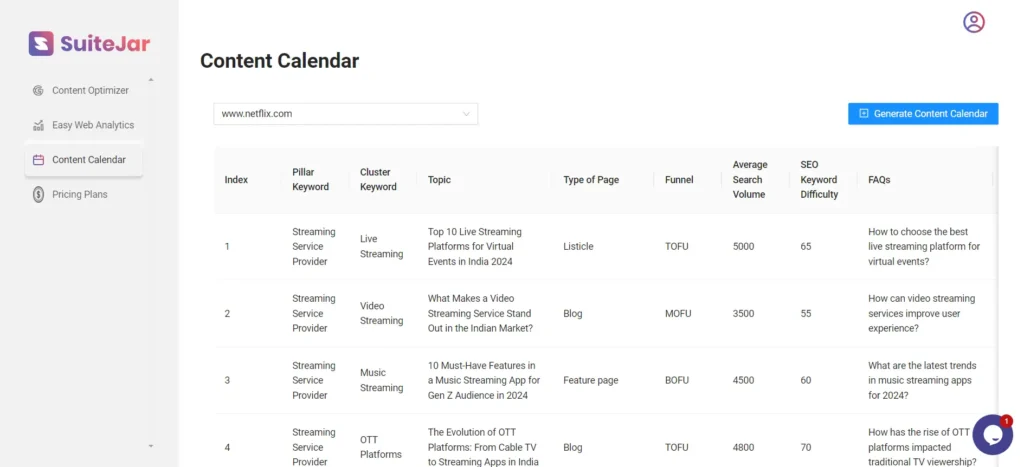
You only need to export this complete sheet with these details and start assigning the tasks to your team effortlessly. You can also rely on SaaS content writing services along with a content calendar generator tool to get things created within seconds without taking up your time.
Benefits of Using a Content Calendar
A content calendar is an indispensable tool for streamlining your content marketing strategy. Here are the key benefits of integrating a content calendar into your SaaS marketing agency :
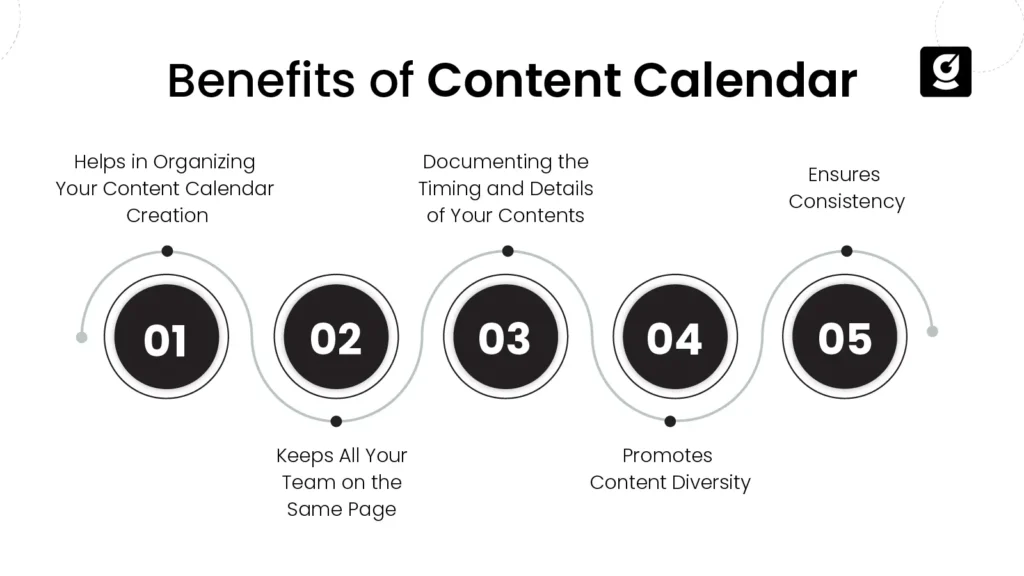
I. Helps in Organizing Your Content Calendar Creation
A content calendar provides a visual overview of your content strategy, mapping out what will be published and when. This organizational tool helps you plan ahead, ensuring that you have a steady stream of content aligned with your marketing goals. It also aids in balancing your content types, from blogs to webinars, ensuring you cover all bases without last-minute scrambling.
ii. Keeps All Your Team on the Same Page
Content creation often involves multiple stakeholders, from writers and designers to marketers and executives. A content calendar acts as a single source of truth for everyone involved, clearly showing deadlines, publication dates, and responsible parties. This transparency reduces confusion and helps synchronize efforts across departments, enhancing teamwork and efficiency.
iii. Documenting the Timing and Details of Your Contents
With a content calendar, every piece of content is accounted for, with specifics about its release date, creator, theme, and target audience. This meticulous documentation makes it easier to track performance over time and adjust your strategy accordingly. It also serves as a historical record, helping you understand seasonal trends and the effectiveness of various campaigns.
iv. Promotes Content Diversity
By planning your content in advance, you can ensure a rich mix of formats and topics, appealing to different segments of your audience. A content calendar helps you avoid content fatigue among your audience by varying the types of content you publish, from in-depth articles to quick tips and engaging infographics.
v. Ensures Consistency
Perhaps one of the most significant benefits of a content calendar is the consistency it brings to your publishing schedule. Regular updates keep your audience engaged and help build a loyal following. Consistency in content delivery also plays a crucial role in SaaS SEO, as search engines favor websites that are continually updated with fresh, relevant content.
Conclusion
So, wrapping up getting your content planning sorted out is very important for your SaaS Marketing Agency. A proper content calendar helps you stay on top, making sure every content is planned out and ready to roll, which can really increase your revenue.
As a tip, using an AI SEO service can make your saas content planning a whole lot easier. It beats up all the details in no time, letting you focus on creating excellent content. So, set up your content calendar, create quality content, and watch your SaaS business grow.

